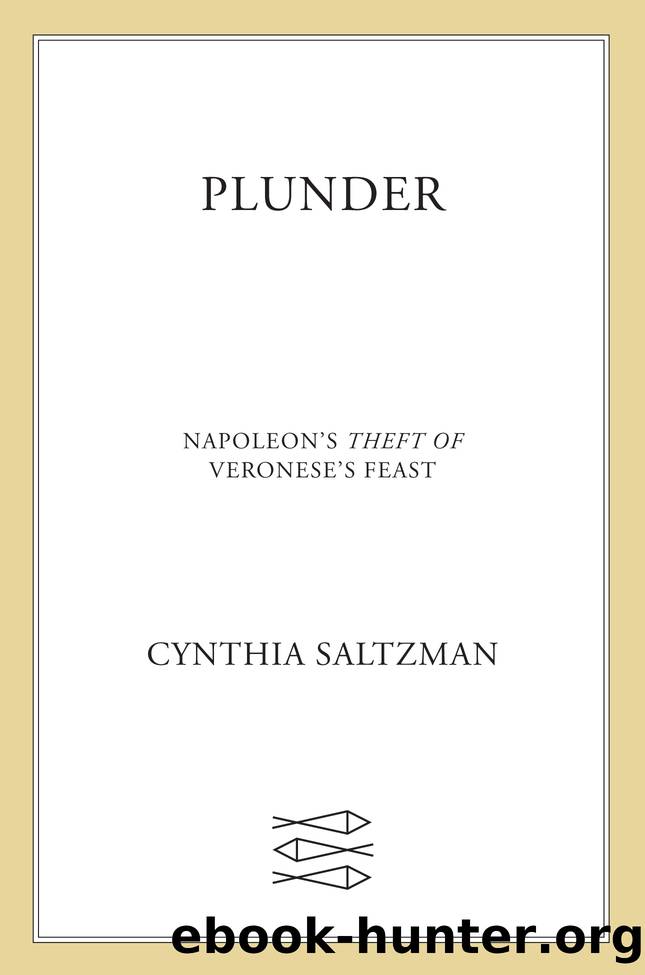Plunder by Cynthia Saltzman

Author:Cynthia Saltzman
Language: eng
Format: epub
Publisher: Farrar, Straus and Giroux
16
âThe transparency of air ⦠place[s] Gros beside Tintoretto and Paul Veroneseâ
The life of Napoleon is the event of the century for all the arts.
âEugène Delacroix
If The Wedding Feast at Cana refused to conform to the rules of French academic taste, hanging prominently in the Louvre, it could hardly be ignored. The Venetian canvas was in its way a subversive presence, to be seen and studied by its most important audienceâthe artists of France. âArtists come running! Here are your masters!â cried the banner on the carts that had paraded the Italian plunder across Paris. Indeed, even those artists who had condemned the French art seizures in Italy did not stay away now that these paintings and sculptures were on display at the Louvre. To French painters, the Veronese threw down the gauntletâin its scale and magnificence. Its scale was the scale that Napoleon was now demanding as he commissioned pictures to commemorate his battles and create a visual history of his reign.
However, for artists who aspired to greatness, such painting commissions were no longer straightforward. One of the most difficult commissions Napoleon offered, in 1803, was to Antoine-Jean Gros. Napoleon has âgiven me a subject to treat,â Gros wrote to the artist Pierre-Narcisse Guérin. âHe had enjoyed describing it to me himself.â The subject was to be a moment of heroism in the Egyptian campaignâa visit Bonaparte made on March 21, 1799, to a hospital set up in an Armenian monastery in Jaffa to minister to French soldiers stricken by the bubonic plague. He had stopped at Jaffa on his way north to take on Ottoman forces in Syria.
Napoleon had much riding on Grosâs painting, hoping the artist would create an image to recast the problematic facts of Franceâs 1801 defeat by the British in Egypt but also to combat reports in the British press of Napoleonâs brutality not only toward the enemy but also toward some of his own troops.
The political landscape was shifting. After only a year, the peace negotiated at Amiens had collapsed. On May 18, 1803, Great Britain had declared war on France. Already, British travelers had begun to evacuate Paris. âFlight was the order of the day,â wrote Bertie Greatheed, a British playwright. âAnd the most judicious prepared immediately for their departure.â
The approach of war had emboldened Bonaparte to expand his power. So too had threats against his life. His minister of police, Joseph Fouché, had foiled a royalist plot, financed by the British and led by Georges Cadoudal, whose treason was punished by execution. To further warn his enemies, on March 15, 1804, Bonaparte ordered French soldiers to cross the border into Baden and arrest Louis de Bourbon Condé, the Duc dâEnghien. Although he knew the duke to be innocent of plotting his execution, Bonaparte still had him brought to the Château de Vincennes, on the eastern edge of Paris, and tried before a military commission, which found him guilty and had him shot. Enghienâs murder enraged the monarchs of Europe, further fueling their distrust of Napoleon.
Download
This site does not store any files on its server. We only index and link to content provided by other sites. Please contact the content providers to delete copyright contents if any and email us, we'll remove relevant links or contents immediately.
| Africa | Americas |
| Arctic & Antarctica | Asia |
| Australia & Oceania | Europe |
| Middle East | Russia |
| United States | World |
| Ancient Civilizations | Military |
| Historical Study & Educational Resources |
Magic and Divination in Early Islam by Emilie Savage-Smith;(1207)
Ambition and Desire: The Dangerous Life of Josephine Bonaparte by Kate Williams(1099)
Operation Vengeance: The Astonishing Aerial Ambush That Changed World War II by Dan Hampton(990)
What Really Happened: The Death of Hitler by Robert J. Hutchinson(887)
London in the Twentieth Century by Jerry White(860)
Time of the Magicians by Wolfram Eilenberger(852)
Twilight of the Gods by Ian W. Toll(825)
The Japanese by Christopher Harding(815)
Papillon by Henry Charrière(810)
Lenin: A Biography by Robert Service(790)
The Devil You Know by Charles M. Blow(788)
Twelve Caesars by Mary Beard(781)
Freemasons for Dummies by Hodapp Christopher;(755)
The Churchill Complex by Ian Buruma(736)
Bohemians, Bootleggers, Flappers, and Swells: The Best of Early Vanity Fair by Bohemians Bootleggers Flappers & Swells- The Best of Early Vanity Fair (epub)(719)
Napolean Hill Collection by Napoleon Hill(709)
Henry III by David Carpenter;(700)
The Enlightenment by Ritchie Robertson(699)
The Rise and Triumph of the Modern Self by Unknown(692)
